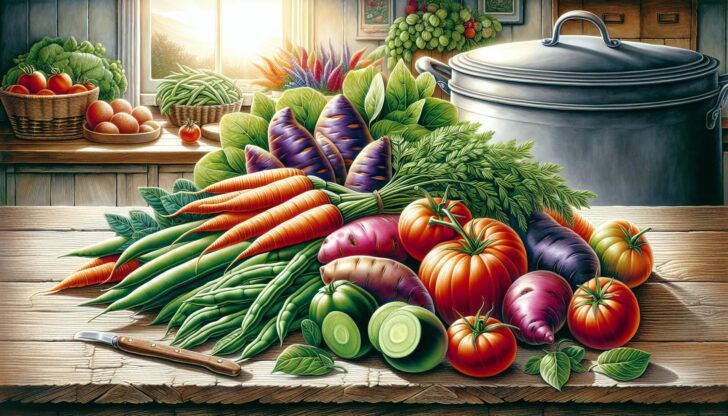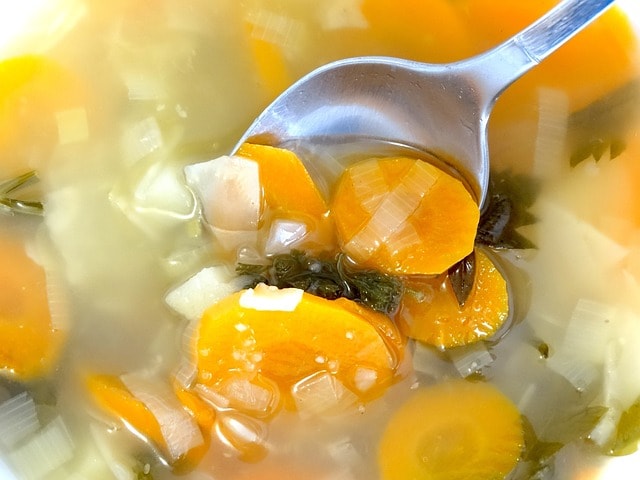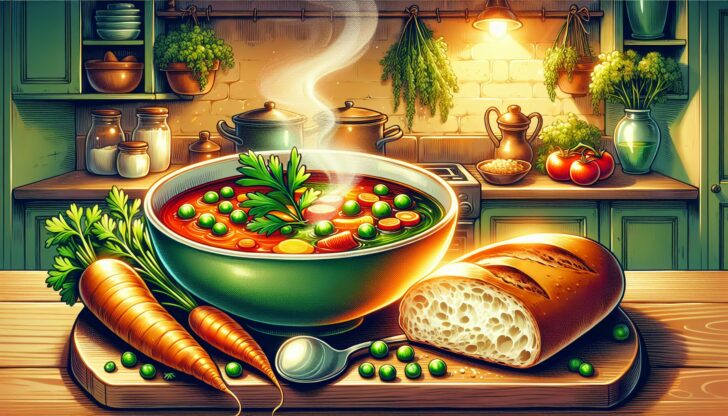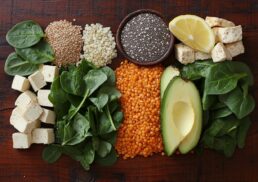Want to make an easy vegetable soup that’s both delicious and quick to prepare? This guide will show you how with an easy vegetable soup recipe. From key ingredients to cooking steps, you’ll learn everything you need to create a flavorful vegetable soup at home. Let’s get started!
Table of Contents
Key Takeaways
Fresh and frozen vegetables are key to a flavorful vegetable soup; use seasonal options for better taste and cost-effectiveness.
Properly sautéing aromatics and layering vegetables based on their cooking times enhances the soup’s flavor and texture.
Customize your easy vegetable soup with different ingredients and sides, like crusty bread or salads, to keep meals exciting and satisfying.
Essential Ingredients for Vegetable Soup

The foundation of any great vegetable soup recipe lies in its ingredients. Fresh vegetables are the heart and soul of this dish, and you can use any combination of your favorites. The base typically includes onions, carrots, and celery, which provide a rich, flavorful start. Carrots, in particular, add a natural sweetness that helps balance the acidity from other ingredients, making it perfect for a homemade vegetable soup recipe.
While fresh vegetables are always a fantastic choice, don’t shy away from using frozen vegetables. They offer the convenience of pre-cut veggies and can be just as nutritious and tasty. Additionally, incorporating seasonal vegetables not only enhances the flavor but also makes your soup more affordable. For an extra flavor boost, consider adding canned diced tomatoes. Quality brands like Muir Glen can enhance the overall taste without the tinny flavor often found in lower-quality options.
The liquid base of your soup is equally important. A good vegetable broth or chicken broth will give your soup a deep, savory flavor. For those looking for a vegetarian option, vegetable stock is a great alternative. With the right broth and a mix of fresh and frozen vegetables, you’ll be well on your way to creating the best vegetable soup.
Preparing Your Vegetables
Properly preparing your vegetables ensures even cooking and the best texture for your soup. Cutting them into uniform sizes ensures they cook at the same rate. For instance, carrots generally take longer to cook than potatoes, so adjusting the size accordingly helps achieve perfect tenderness for all ingredients.
Different cutting techniques can also enhance your soup’s texture and appearance. Dicing vegetables, for example, creates small, uniform cubes that cook evenly. Julienning, on the other hand, produces long, thin strips that can add a unique texture to your soup.
Whether you’re mincing garlic for a burst of flavor or chiffonading leafy greens for a beautiful garnish, the way you cut your vegetables plays a significant role in the final dish.
Sautéing for Maximum Flavor
Sautéing your vegetables before adding broth is a game-changer in terms of flavor. Aromatics like onions, carrots, and celery form the flavor foundation of your soup. Start by heating some olive oil or butter in a large pot over medium-high heat and add your stage 1 aromatics, such as onions and celery, which require longer cooking times. Sauté them until they’re softened and slightly golden.
Next, add your stage 2 aromatics, like garlic and ginger, which are more heat-sensitive and should be added later to prevent burning. Sautéing garlic until fragrant, usually just a minute or two, is key to avoiding bitterness and achieving a deep, rich flavor. Enhance the flavor profile by adding Italian seasoning at this stage, creating a savory and aromatic base.
This step ensures your vegetable soup has a flavorful base that will make every spoonful delightful.
Building the Soup Base with Canned Diced Tomatoes

Once your aromatics are sautéed to perfection, it’s time to build your soup base. Begin by adding vegetable broth or chicken broth to the pot. This liquid foundation will carry the flavors of your vegetables and seasonings, creating a rich and savory soup. If you’re aiming for a vegetarian soup, vegetable broth is the way to go.
Next, introduce canned diced tomatoes to the mix. These can be fire-roasted or regular, depending on your preference. Canned diced tomatoes add both acidity and sweetness, balancing the flavors beautifully. Opt for quality brands like Muir Glen to avoid tinny flavors and improve the overall taste of the dish. Season the soup with bay leaves, red pepper flakes, and salt to enhance its complexity. If you prefer a spicier soup, consider adding a dash of hot sauce or fresh chopped jalapeños.
Remember to taste and adjust the seasoning as you go. If you’re sensitive to spice, you can reduce or omit the red pepper flakes to suit your palate. With a well-seasoned base, your vegetable soup will have a depth of flavor that makes it irresistible.
Adding Fresh Vegetables and Fresh Vegetables
Now comes the fun part—adding a variety of fresh vegetables to create a vibrant and nutritious soup. Start with heartier vegetables like sweet potato, butternut squash, and carrots, which need more time to cook. These veggies not only add beautiful color to your soup but also provide a range of vitamins and minerals.
As you continue cooking, add more delicate vegetables like green beans, corn, and peas. Green beans, for example, offer a satisfying crunch and are packed with vitamins A, C, and K. Near the end of the cooking process, incorporate leafy greens like spinach or kale. These greens boost the nutritional value of your soup with iron and calcium and should be added just before serving to retain their vibrant color and nutrients.
Using a mix of fresh and frozen vegetables can be both convenient and fresh. The key is to layer your vegetables according to their cooking times, ensuring each one reaches perfect tenderness without overcooking.
Simmering to Perfection
With all your vegetables added, it’s time to let your soup simmer to perfection. Heat the soup over medium-high heat until it reaches a gentle simmer. This process allows the flavors to meld together, creating a harmonious and delicious broth. Let the soup simmer until all the vegetables are tender, which usually takes about 25-30 minutes, depending on the size of your vegetable pieces.
Stir the soup occasionally to prevent the ingredients from sticking to the bottom of the pot and to ensure even cooking. Taste the soup as it simmers and adjust the seasoning as needed. This is your chance to fine-tune the flavors, making sure your vegetable soup is perfectly balanced and full of flavor.
Finishing Touches
As your soup finishes cooking, it’s time to add the final touches that will elevate its flavor. Fresh herbs like basil, thyme, oregano, and marjoram can make a significant difference. Adding a squeeze of fresh lemon juice at the end enhances the soup’s freshness and brightens its flavors.
Season the soup with freshly ground black pepper just before serving to give it an extra kick. Adjust the seasoning with salt and pepper to taste, ensuring the flavors are just right. These finishing touches will make your vegetable soup truly stand out, creating a bowl of soup that’s both comforting and delicious.
Health Benefits and Nutrition of Vegetable Soup
Vegetable soup is not only delicious but also a powerhouse of nutrition. Incorporating a bowl of vegetable soup into your diet can offer numerous health benefits that go beyond just satisfying your hunger.
Learn more, visit Health Benefits of Vegetable Soups | by Nutrition Journeys
Slow Cooker and Instant Pot Options
A slow cooker or Instant Pot offers a hands-off approach. In a slow cooker, mix together onions, carrots, garlic, potatoes, and tomatoes. Then, add fresh green beans, herbs, broth, salt, and pepper. You should cook on low heat for a duration of 4 to 6 hours. Alternatively, you can cook on high for 2 to 4 hours. Add peas and corn during the last 30 minutes of cooking for the best texture.
If you’re using an Instant Pot, start by sautéing the aromatics like onions and garlic before adding the rest of the ingredients. Cook the soup for about 12 minutes on the pressure cooking setting.
These methods not only save time but also infuse the soup with rich, deep flavors, making it a tasty and convenient option. This makes it an easy vegetable soup recipe that is perfect for families and health-conscious individuals.
Storing and Reheating Vegetable Soup
Leftover vegetable soup can be a lifesaver on busy days, but it’s important to store it properly to maintain its flavor and freshness. Store the soup in an airtight container to prevent it from absorbing odors and to protect it from bacteria. Allow the soup to cool to room temperature before storing it in the refrigerator to avoid condensation, which can dilute the flavor.
When you’re ready to reheat the soup, make sure it’s heated thoroughly to preserve its flavor and texture. Reheat it on the stove over medium heat, stirring occasionally, until it’s hot all the way through. Proper storage and reheating will ensure that your soup tastes just as delicious as when it was first made.
Delicious Variations

One of the best things about veggie soup is its versatility. You can easily customize your soup with different ingredients to suit your tastes and dietary needs. For added protein, consider using beans like chickpeas or lentils. These not only make the vegetable soup heartier but also add a nice texture.
You can also incorporate seasonal vegetables to keep your soup fresh and exciting. Add zucchini in the summer or root vegetables like parsnips in the winter. If you like a bit of heat, adjust the amount of red pepper flakes or add a dash of hot sauce.
For a different flavor profile, try sautéing your vegetables with Italian seasoning and garlic before simmering them in broth. This will create a savory and aromatic base for your soup.
For a more substantial soup, toss in some small pasta shapes like orzo about 10 minutes before the soup is done cooking. These variations keep your vegetable soup interesting and delicious every time you make it.
What to Serve with Vegetable Soup
A hearty bowl of vegetable soup can be a meal on its own, but pairing it with the right side dishes can elevate your dining experience. Crusty bread is a classic choice that complements the soup’s rich flavors and provides a satisfying texture. It’s perfect for sopping up every last drop of the flavorful broth.
Garlic bread offers a rich, buttery contrast to the lightness of the soup, making it an excellent side dish. For a lighter option, a fresh salad adds a crisp and refreshing element to your meal, balancing the warmth and richness of the soup. These sides make your meal more complete and enjoyable.
Summary
Making a delicious vegetable soup is easier than you might think. By selecting fresh and seasonal ingredients, preparing them with care, and following the cooking steps outlined in this guide, you can create a bowl of vegetable soup that’s both nutritious and satisfying. Whether you prefer a traditional stovetop method or the convenience of a slow cooker or Instant Pot, this recipe is versatile enough to suit any cooking style.
We hope this guide has inspired you to make your own homemade vegetable soup. Experiment with different ingredients and variations to find your perfect recipe. Enjoy the process, and happy cooking!
Frequently Asked Questions
Can I use frozen vegetables instead of fresh ones?
Absolutely, you can use frozen vegetables instead of fresh ones! They’re convenient, nutritious, and can save you a lot of prep time while still tasting great.
How long can I store leftover vegetable soup?
You can safely store leftover vegetable soup in an airtight container in the fridge for about 4-5 days. Just make sure to heat it thoroughly before enjoying it again!
Can I make this soup in a slow cooker?
Yes, you can definitely make this soup in a slow cooker! Just mix all the ingredients and cook on low for 4-6 hours or high for 2-4 hours, adding any delicate veggies in the last 30 minutes.
What can I add to make the soup more filling?
To make your soup more filling, try adding beans like chickpeas or lentils, or toss in some small pasta shapes like orzo. These ingredients will definitely give your soup a heartier texture!
How can I adjust the spice level of the soup?
You can easily adjust the spice level of your soup by adding more red pepper flakes or hot sauce for extra heat, or by simply using less of those ingredients if you want to tone it down. It’s all about your personal preference!









